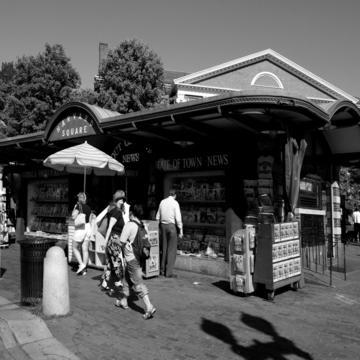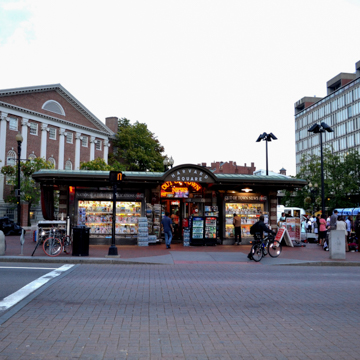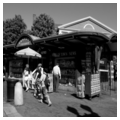Harvard Square represents the undisputed hub of Cambridge and much more. Its powerful mental construct may be at odds with the physical reality of the Square upon initial encounter, especially when emerging from the glazed structure of the underground T. As a pivotal axis for the city's transportation network, the Square is a place of dense activity, ever in the process of transformation, according to times of day and seasons of the year. Entering along Massachusetts Avenue from the east, the Square turns sharply to the north. Dominated by the copper-vaulted kiosk, now Out of Town News (built as the Harvard Square head house in 1928 and restored in 1984), the space provides access to underground transit and an information booth. Within, a free curvilinear arena embraces the subway entrance; street furniture includes an information booth, an elevator (disguised by posters), and Dimitri Hadzi's sculpture Omphalos (1985), commissioned for the MBTA through the Cambridge Arts Council's Arts on the Line program. The small stepped arena, known as the Pit, is the center of action, often improvised and spontaneous, a direct outcome of student upheavals of the 1960s calling for more active participation in a richer urban life.
On the east and north sides, framed by buildings of Harvard, gates lead to Harvard Yard; the Harvard Co-op is opposite, part of it now a Barnes & Noble bookstore. In this intersection where town meets gown, the surrounding commercial activity has changed from modest retail shops and bookstores to a plethora of banks, boutiques, and businesses catering to the luxury and college student trades. Red brick buildings, enclosing Harvard Yard, the Harvard Co-op and a few Neo-Georgian buildings of the 1920s still remain. Community engagement in the development of the area was particularly evident in the early 1970s, when local forces blocked the building of the John F. Kennedy Museum and Library, stressing the negative environmental impact it would have on the city in terms of local services and circulation.


















